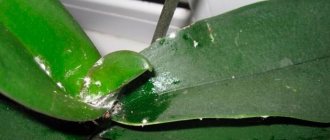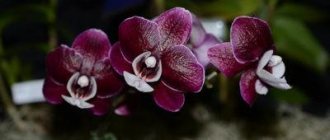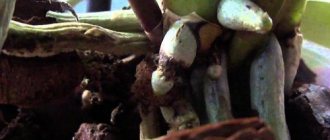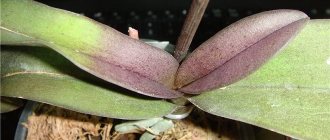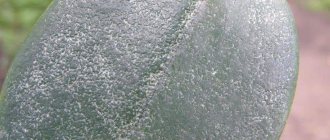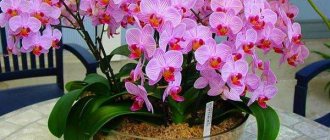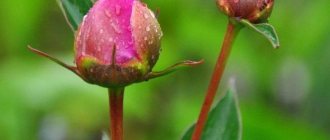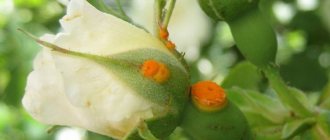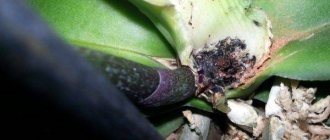Scale insects on an orchid are quite common if the flower is not properly cared for. The orchid is a very beautiful indoor flower that is easy to care for. If you do not maintain temperature conditions, do not maintain humidity and do not water the flower correctly, you may encounter insects that very quickly attack the plant.
You should start worrying as soon as you notice spots on a flower, wilting of a plant or plaque on the leaves. Scale insects are the most common pest of orchids, so it is important to know the “enemy” by sight, and it is also important to know how to fight it. In this article we will learn what types of scale insects exist and what harm they can cause to an orchid, as well as how to deal with annoying pests.
Definition: what kind of parasite is this?
The scale insect (family Diaspididae) and the false scale insect (family Coccidae) are representatives of the order of homoptera insects of the suborder Coccidae. Insects feed on the sap of plants (household, garden and forest) from:
- leaves;
- shoots;
- fruits;
- branches;
- trunks.
Depending on the species, the body can be rounded or elongated. Color varies from light to dark brown. Sometimes there is a purple tint. The body of the scale insect is covered with a waxy shell, which is protection for the future generation.
False scale insects are distinguished by the fact that they do not have a shell, and the larvae and eggs are protected by the dying skin of the female. The size of the scale insects of adult insects does not exceed 5 mm, and the size of the false scale insects does not exceed 7 mm.
Insect larvae are called strays. When they hatch from eggs, they spread throughout the plant. Juveniles are oval-shaped, light yellow in color and very mobile. They have eyes, three pairs of legs and antennae.
Stragglers attach to leaves and stems. The limbs gradually die off.
Insects are covered with a dense wax shell. The color of the shell varies from white to brown. The larvae molt twice and develop into adult females and males. Males become mobile. They grow legs and wings, but their mouthparts are atrophied. After fertilization they die. Depending on the species, females lay eggs under the shield or give birth to larvae (up to 1000 pieces). Then they die.
Features of mealybug
The mealybug is a fairly large insect with a characteristic appearance. Despite the fact that this insect can be easily seen without special equipment, many novice gardeners notice it too late, which makes it very difficult to get rid of such a pest.
The length of the insect varies from 0.3 to 1 cm. The male and female can be easily distinguished externally. The female has an oval-shaped body, it is covered with white powder wax, she has long thread-like mustaches and a large number of short legs. The pest larva is similar in appearance to the female, but it is much smaller. Males are winged insects that look like a mosquito or fly. Males do not have mouthparts, so they cannot harm the plant.
How dangerous are scale insects for plants? Such sucking insects use plant cell sap as food. The growth of the bush on which the pests have settled initially becomes slower, then the plant stops growing and developing altogether. As a result of their vital activity, such pests produce honeydew, or honeydew, which is a sticky sweet liquid. Honeydew is a favorable environment for the development of various fungal diseases, and sooty fungus most often settles on it. Such an insect injures all organs of the plant (both the root system and above-ground parts) and can easily move to another bush located nearby. The most common types are: greenhouse lamella, bamboo, citrus, seaside, grape, Australian grooved, root, bristle and Comstock.
How to determine its appearance?
Seeing the pest at the beginning of its development is a difficult task (due to its small size - 0.3 mm long).
- The first symptoms of scale insect infection are sticky orchid leaves. This is a sticky honeydew that clogs the pores and prevents the plant from breathing. The insect secretes it during its life.
- Then small yellow-brown tubercles appear, which are located on the leaf blades, young shoots and orchid flowers. Gradually the number of such yellow spots becomes larger.
Timely measures taken to destroy the pest will help save the orchid.
Application of growth stimulants and nitrogen fertilizers
When getting rid of pests, you should not use :
- Various fertilizers;
- Growth stimulants.
At the time of illness, the orchid will not grow new leaves and it will not accept the stimulant. Therefore, an excess of nitrogen fertilizing will lead to softness of the leaf plates and the possibility of their rotting. All the flower needs is a poison that will rid it of the pest.
How to fight insects and cure a flower?
First it is necessary to carry out mechanical processing. Stages of orchid processing:
Thoroughly wash the window and window sill with disinfectants.- To catch active insects, use sticky tapes that are placed near the flower.
- Leaves and shoots with a degree of infection greater than 50% should be cut off.
- Replace topsoil.
- Wash the leaves and flower stalks with warm water using a soft brush and soapy water (to remove sticky honeydew).
- Dry the plant for 1-1.5 days.
- Carry out treatment using folk, biological or chemical means (depending on the degree of infection).
The treatment is repeated after 7-10 days.
Folk recipes
At the initial stage of infection, folk remedies are used:
| Means | Application |
| Garlic | Finely chop and apply to the insect attachment site, or rub with half a slice. |
| Garlic and soap |
|
| Onion | Rub the pest or fill the finely chopped onion with water and then spray the plant. |
| Alcohol | Spot-processed. But be careful, as it can cause leaf burn. |
| Vegetable oil | Two tablespoons per 1 liter of water. |
Biological agents
If folk remedies do not help, you can treat with biological or chemical agents.
| A drug | Action, application |
| I cheated | Causes death of eggs and larvae. It is necessary to spray so that the entire plant is covered with the preparation so that it “drips from the plant.” Till the soil thoroughly. |
| Fitoverm | It provokes paralysis of pests and they stop feeding. Death occurs on the third day after treatment. Full effect – after 6-7 days. |
| Nemabact | The nematode contained in the preparation integrates into the larva and destroys it. |
| Avertin | Leads to paralysis by affecting the nerve endings of parasites. |
Chemicals
| Insect | Appropriate use of drugs |
| Shchitovka | Intestinal and systemic action. |
| False shield | Intestinal, systemic and contact action. |
The absence of a durable shell in false scale insects does not prevent the penetration of contact poison.
| Name | A drug | Operating principle |
| Intestinal |
| They begin to act only after the pest enters the body. |
| System |
| The active substance enters the plant juice through the roots and leaves. Makes it poisonous to parasites. |
| Contact |
| Penetrates the body of pests through the skin. |
Biological and chemical agents must be used strictly according to the instructions. After any treatment, flowers should not be placed in direct sunlight, so as not to cause burns on the plant.
When using oil-based preparations, the solution is applied pointwise - only to the insect. If the product is sprayed, the pores on the leaves may become clogged, oxygen starvation and, as a result, the death of the plant.
Next, you can watch a useful video on how to deal with scale insects on an orchid:
Control measures
How to get rid of a pest? The first immediate step when a scale insect is detected is to separate the infected specimen into a quarantine zone.
This is necessary so that the males do not run over to neighboring flowers. Especially if the flowers are very dense.
During the entire treatment, the flower is in the quarantine zone and even 2 weeks later remains in it. This is necessary in order to be completely sure that the pest is no longer on the flower.
Way to get rid of scale insects:
- It is necessary to mechanically remove all visible shields, since the chemical will not get under them during processing;
- Wash all leaves and flower stalks with soapy water, getting rid of sticky residue;
- Only after this do they begin to process the plant.
If the infestation is small, then you can try to get rid of the insect using traditional methods, but with a large infestation they do not produce results.
Folk remedies
How to fight scale insects with folk remedies? Since this is not a new pest and people have been fighting it for a long time, there are certain folk remedies to get rid of it.
Garlic juice
To do this, cut off the tip of a clove of garlic and, using the protruding juice, treat the places on the leaf blades where the pest was noticed.
A folk remedy for fighting scale insects is rubbing the orchid leaves with garlic juice.
But if the damage occupies a large area, then the garlic is grated on a fine grater or crushed using another method, the main thing is that it releases juice and turns into pulp. After which this paste is spread on the affected leaf.
Olive oil
To do this, make a composition by mixing 2 tbsp. spoons of oil with a liter of water. The orchid is treated with this infusion three times with an interval of 7 days.
Soap and alcohol
To do this you need to mix:
- Liter of water;
- And 10 ml. alcohol;
- Adding 15 grams there. liquid soap or dishwashing detergent.
Mix everything thoroughly and wash the plant where the scale insect was noticed.
Biological agents
Fitoverm - fights scale insects quite well. It is used in cases where, for various reasons, it is impossible to carry out chemical treatment, and traditional methods do not help to completely get rid of it. This drug is of biological origin and is not dangerous for humans and their animals.
To make a solution of the drug, 2 ml. diluted in 200 gr. water and spray the affected plant. This drug can be used to treat other plants in the house to prevent the disease. You also need to wipe the place where the affected flower stood.
To completely remove scale insects, treatment is carried out three times after 7 days.
Fitoverm.
Promanal is considered non-toxic and is used at home not only against various types of scale insects, but also helps get rid of ticks and scale insects. It affects egg laying and the larvae die without hatching. When treating an orchid, it must be thoroughly sprayed so that the solution drips from the leaves. In this case, the substrate must also be treated, since it may contain eggs and larvae.
Promanal is a remedy that helps plants fight pests.
Avertin is a broad-spectrum drug designed to remove pests. It affects the nervous system of the pest, causing its paralysis. Processing is carried out according to the instructions indicated on the packaging.
Nemabakt - the weapon of this biological product is a nematode, which penetrates the scale insect larva and eats it. The drug is absolutely harmless to beneficial insects, people and pets. The nematode continues to fight the pest for quite a long time, and the latter has no chance of surviving against it.
Biological drug Nemabact.
Insecticides
If the orchid is completely affected by this harmful insect, then it is worth using chemicals that can save the plant. When working with such drugs, you must be careful and if they come into contact with the mucous membrane or skin of a person, you must rinse everything well under running water.
Permethrin
The drug is quite effective and one treatment is enough to remove the parasite.
Permethrin helps the orchid fight pests well.
Penetrates the scale insect through the skin.
Aktellik and Aktara
These drugs are treated three times with an interval of 5-6 days. It is very toxic and must be processed outside. Penetrates insects through the oral cavity.
Prevention of re-infection
Preventative actions for the reappearance of pests are as follows:
- cure the orchid from other diseases (if any);
- create favorable conditions for growth and flowering (required level of lighting and humidity);
- If infected specimens are identified, immediately quarantine them and begin pest control;
- Keep “newcomers” in pots separately from other flowers (2 – 4 weeks).
If an orchid is infected with scale insects or false scale insects, urgent measures must be taken. Otherwise, the flower may die, and not only shed buds or leaves. Control methods depend on the personal preferences of the owner and the degree of infestation.
Types of scale insects
differs from the false scale insect :
- Scale insects have a convex shell;
- False scale insects have a flat shell.
There are different types of scale insects that are found on orchids:
- Californian;
- Brown;
- Oleander;
- Palm;
- Cactus.
You can add scale insects to your home collection by purchasing a new plant that is already infected and has larvae on it.
IMPORTANT! Any new plant must be quarantined, where it will stand separately from other plants for 2 weeks. This time is necessary to ensure the health of the plant.
Aphid
Aphids on an orchid can also be seen with the naked eye: these are small green or black insects that most often settle on the underside of young leaves, sprouts and flowers of the plant. The presence of aphids can be determined by the following signs: the orchid leaves become deformed and become sticky. Like scale insects, aphids suck the juices out of the orchid and inject a toxic substance inside that destroys the plant cells. Insects are also dangerous because they are carriers of viral diseases and fungi.
How to get rid of aphids
If you find pests when there are not too many of them yet, then thoroughly “bathing” the entire plant in the shower will help you deal with aphids. In this case, damaged flowers and buds from the orchid must be removed.
If there are a large number of insects, it is worth using a soap solution. It acts as an antiseptic, which is detrimental to many insects. You can treat the orchid either with laundry soap foam or with dishwashing liquid diluted in 1 liter of water (1 tbsp). After such treatment, it is recommended to spray the flower with Fitoverm or a solution of the drug Alatar.
Aphids on orchid leaves
Folk remedies
You can cope with aphids on an orchid using infusions. For example, onion infusion, which is prepared from an onion crushed into pulp, is poured with boiling water and infused for about 7 hours. The strained product should be sprayed on the orchid for 3-4 days several times a day.
Another effective infusion is prepared from citrus peels. Dried zest of lemons, oranges or tangerines (100 g) should be poured into 1 liter of water and left for 3 days. After this, the resulting infusion must be sprayed on the aphid-damaged orchid for several days every 4-5 hours. To consolidate the effect, dry citrus peels can be placed on the soil in a pot.
In order to protect the orchid from aphids, the tropical plant must be kept in conditions favorable to it.
In particular, it is extremely important to ensure sufficient humidity in the room - from 60% and above. Sufficient watering and timely fertilizing are also necessary.
Species that parasitize orchids
Scale insects affect many orchids, but more often than others they settle on plants with hard elastic leaves: paphiopedilums, dendrobiums, stangopeas, cymbidiums, cattleyas, phalaenopsis, bletillas, pleion.
The most famous types of scale insects seen on orchids are:
Palm tree (Diaspis boisduvalii) is a whitish-yellow or light brown insect. The female's body is short-oval, the scutellum is round. The protective shell of the male is long. More often it settles on palm trees, especially young fan palms, and banana plants, but if an orchid is nearby, it also moves to its foliage.
Palm (Diaspis boisduvalii)
Orchid (Pseudoparlatoria parlatorioides) - the body of the insect is ovoid, the scutellum is rounded and convex, yellowish-brown in color with two larval skins, often extending beyond the scutum. Males have an oblong carapace, with almost parallel opposite edges, the same color as that of the female. Larvae and adult females damage the leaves; yellowish spots form on them around the puncture sites. In addition to orchids, it also parasitizes other plants.
Orchid (Pseudoparlatoria parlatorioides)
Bromeliad (Diaspis bromeliae) – yellowish-cream color, small, only up to 2.5 mm long. The body is pear-shaped and appears translucent. The scutellum is rounded, in the male it is long. Harmful to palm trees, orchids and bromeliads.
Bromeliad (Diaspis bromeliae)
Orchid comma (Lepidosaphes machili) – the female’s body is elongated, but the front part with the head is narrower than the rest. Its scutellum partly follows the shape of the body, curved, in the shape of a comma, expanding towards the back. The male has an elongated carapace. Only affects orchids.
Orchid comma (Lepidosaphes machili)
Oleander (Aspidiotus nerii) - females are yellowish, with a rounded-ovoid shield, males have an elongated shell shape and are covered with reddish spots. They parasitize many plants - olive, palm, orchid, laurel, and are found on yucca, oleander, asparagus, acacia and other plants.
Oleander (Aspidiotus nerii)
The soft scale insect (Coccus hesperidum) is a viviparous insect that can give birth to up to 1 thousand young individuals. The scutellum is flat, elliptical, yellow-brown in color, with a distinct vein in the middle. The insect's body is asymmetrical and broadly elliptical. Settles on leaf blades on the lower and upper sides, on stems and tuberidia.
Soft scale insect (Coccus hesperidum)
Hemispherical false shield (Saissetia coffeae) - named for the shape of a flat-convex shield, reaching a length of 4 mm, smooth and dark brown to blackish in color. After the eggs mature, the female dies, the shell rises, and the larvae crawl at a very fast pace along the leaf or stem.
Hemispherical false scale (Saissetia coffeae)
Preventive protection measures
Taking preventative measures helps avoid infection of healthy orchids. Primary prevention includes mandatory isolation of the newly acquired flower.
The duration of quarantine is at least 2 weeks. This is enough to identify diseases and pests present in the plant and carry out treatments with fungicides and insecticides.
To maintain orchid health:
- provide proper care;
- carry out periodic feeding;
- organize regular treatments against infectious diseases and pests.
After treatment, in order to avoid secondary infection, all furniture surfaces and window sills in the room are additionally treated.
General information
According to the general encyclopedia, scale insects are small hemiptera insects that belong to the superfamily of scale insects. This name is due to the presence of a hard covering of the body, reminiscent of a shield.
This peculiar shell consists of 1 or 2 connected skins, under which there is a waxy secretory part (scale insects secrete a sticky liquid). False scale insects do not have a hard shell. Instead, insects have a thin shield formed from dying skin. Insects do not secrete liquid, but inject poison into the plant.
REFERENCE! The shell of scale insects is part of the body; it is firmly attached to the body. Pseudoscale insects have a thin shell that can be easily lifted. The sticky substance secreted by scale insects provokes the onset of sooty rot.
What should you not do?
It is prohibited to use products that contain nitrogen, stimulants or growth regulators to eliminate parasites. Possible names include Zircon, Epin. These drugs will only increase the reproduction and spread of the pest. It is also not recommended to collect scale insects by hand . In this way, you violate the integrity of the shell and open a passage for the young individuals that live under it.
Did you buy a new flower or was it given to you? Congratulations! But we recommend keeping the pot separate from other orchids for 10 days. This is necessary to ensure that your pets are not exposed to pests. On our portal we will tell you in detail how to deal with mites, including spider mites, thrips, midges, mealybugs, aphids, beetles and other small insects.
Instructions
First you need to prepare the solution, observing the dosage:
- The granular product must be diluted. Typically, flower growers take a 1.4 g sachet. Prepare a mother solution - part of the granules is dissolved in a small amount of water. Then it is brought to the required volume by adding the remaining dry matter and water according to the instructions. Shake well before use.
- The liquid product should be diluted in the same proportions and dosage as the granular product.
- For spraying, the optimal dose is 1 g per 10 liters of water. This amount is enough to process about 120 plants. If you need to water at the root, use 4 g per bucket of water.
What is the danger of the pest
Scale insects feed on plant sap, which they suck from plants. Phalaenopsis and Cymbidium orchids are at risk. After drinking the juice, the scale insect injects poison into the voids that appear. Affected leaves become covered with multi-colored spots and soon die.
Honeydew secreted by females contributes to the development of fungal diseases. It envelops the plant, interfering with the process of photosynthesis. Due to lack of sunlight, orchids quickly weaken and die. The sweet, sticky substance attracts ants. Small pests multiply quickly, affecting neighboring plants.

